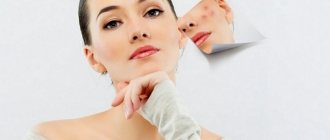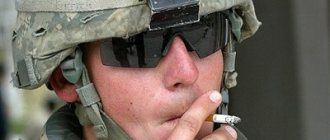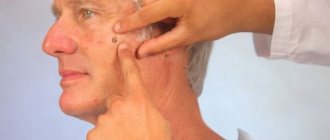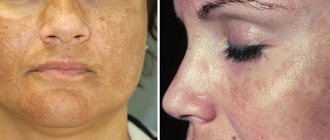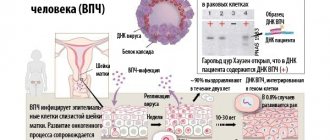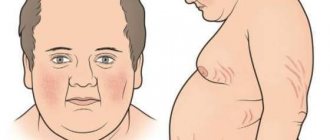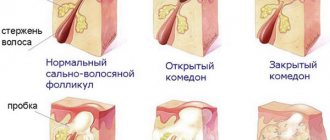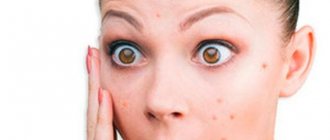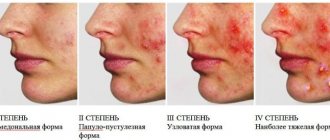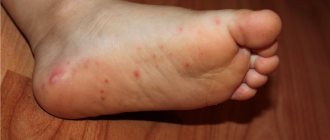Last update: 01/14/2020
Doctors call allergies the disease of the century. It is not surprising, since every tenth inhabitant of our planet is susceptible to it. The most unpleasant thing is that this disease occurs in children even more often than in adults.
The most common allergy in children in the first years of life is food. When it appears you must:
- If the baby is breastfed, then the mother needs to exclude from her foods that can cause allergic rashes on the skin of children.
- If the baby is bottle-fed, then it is worth changing the formula.
- If the child is 2-3 years old, then allergens need to be removed from the diet. Most often these include citrus fruits or sweets.
It is not surprising that allergic skin rashes in children worry parents. The main thing is not to panic! Let's figure out what influences the occurrence of an allergic reaction in children? Firstly, heredity. If one of the parents is allergic, then the probability of the disease occurring is 50%, and if both parents suffer from this disease, then the risk increases to 80%. Secondly, ecology. We are talking not so much about gas pollution in cities, but about lifestyle: synthetic clothing, household chemicals, food.
Kinds
Allergic rashes in children affect not only the skin, but also damage to the mucous membranes of the eyes and nose. Particularly dangerous is a generalized allergic reaction that affects the respiratory tract, cardiovascular and endocrine systems, often leading to anaphylactic shock and death.
The types of allergic rashes in children by origin come down to two main options: caused by poor diet or contact with an allergen.
Food
Rash due to food allergies in children is most often caused by foods introduced in the form of complementary foods, artificial formula, and breast milk due to poor nutrition of the mother. An allergic rash in a one-year-old child is associated with errors in diet and drug therapy prescribed for various reasons.
With food allergies, the rash in a child does not have a clear localization, is usually widespread and appears in the form of spots. Parents note an increase in skin manifestations after feeding.
Non-food
A non-food type of allergic rash in an infant occurs quickly after local exposure to an irritant, since the immune defense mechanisms are not fully formed, and the skin is delicate and extremely vulnerable.
If the allergen is identified in time and contact with it is eliminated, the pathology is only local in nature and can be easily eliminated. It is often provoked by the use of low-quality diapers, creams, and powders. Non-food allergies in a child usually present as a rash on the legs. Small red spots are also often located on the buttocks.
Pimples on feet
Photo 25 – Pimples on the feet
It is necessary to remember once and for all that ordinary acne does not appear on the feet, because there are no sebaceous glands on the feet, and therefore the occurrence of a rash is a symptom of one of three diseases, such as:
- Dyshidrotic eczema. Occurs due to skin contact with irritating substances. In this case, pimples are bubbles that burst and release a clear liquid. Photo 26 - Dyshidrotic eczema
- Dyshidrosis. Presents as a numerous rash of red blisters on the feet; Photo 27 - Dyshidrosis
- Itchy dermatitis. This disease often manifests itself due to the use of antibiotics, exposure to household chemicals, or too tight, uncomfortable shoes in which the feet constantly sweat. It appears as redness and small watery pimples on the foot. At the same time, acne constantly itches. Photo 28 - Itchy dermatitis
Causes
The appearance of an allergic rash in a baby is due to the following reasons:
- illnesses of a woman during pregnancy;
- complications during childbirth, perinatal pathology;
- the presence of allergic diseases in the father or mother;
- taking antibiotics, antiviral and vitamin preparations and other medications by a nursing woman;
- maternal malnutrition;
- artificial feeding;
- drug therapy prescribed to the baby due to illness;
- low-quality children's clothing made from synthetic fabrics;
- bad ecology;
- bites of blood-sucking insects;
- prolonged exposure to fresh air during the flowering period of various plants (birch, quinoa, wormwood, poplar);
- frequent hypothermia;
- excessive insolation during summer;
- long stay in a dusty room;
- close contact with pets (fur, saliva, fluff).
An allergic rash in children under one year of age can be caused by immunodeficiency, disruptions in the enzymatic activity of the stomach or intestines, or the presence of parasites.
A mild allergic rash in a newborn on the face and chest is often explained by the removal of mother’s hormones obtained in utero. Manifestations of exanthema disappear without medical intervention.
Allergic acne on the face
Having determined what allergic acne looks like and found out the reason for its appearance, we proceed directly to getting rid of them.
Photo 13 - Treatment with folk remedies
When using folk remedies, if allergic acne occurs on the face, the first thing to do is wash your face, for example, with a decoction of calendula. You can also use it to make ice cubes for wiping your face. With the help of boric and salicylic acids, you can dry out watery and purulent pimples.
Photo 14 - Boric and salicylic acid dries out acne
Potato starch also helps a lot in the fight against such acne.
Photo 15 - Potato starch against allergic acne
Regular tea, which should be kept on the affected area, will also help get rid of acne.
Photo 16 – Try anti-acne tea
Symptoms
An allergic rash on a child’s body is usually represented by the following elements:
- pink or red spots of various sizes, often prone to merging;
- vesicles, sometimes with hyperemic edging;
- pustules, or small pustules that form when scratching and when a secondary infection occurs.
An allergic rash on the body of a baby is accompanied by swelling of the subcutaneous tissue, thickening of the skin, weeping or dryness. The child is worried about burning and itching. After the severity of the process decreases, skin cracks and peeling appear, crusts form on the cheeks, and faint pigmentation is possible.
In advanced cases, for all types of allergic rashes in children, a violation of the general condition is typical:
- anxiety, causeless crying;
- decreased appetite, regurgitation;
- constant lacrimation, conjunctivitis;
- sleep disturbance due to itchy skin;
- difficulty breathing, coughing.
If a breastfeeding woman consumes allergenic foods, urticaria appears within 3-24 hours. Characterized by unstable stools, in which constipation alternates with diarrhea, often mixed with greens and mucus. Food allergies affect the skin of the face, neck, and forearms. Sometimes it is possible for a child to develop an allergic rash on his stomach. In severe cases, life-threatening Quincke's edema develops.
A rash in an infant with an allergy caused by external factors is initially localized at the point of contact - in the elbows, armpits, popliteal fossae, and on the inner thighs. The soles become red and swollen, and blisters appear on them, the contents of which tend to suppurate. Elements of an allergic rash are often found on a child’s bottom.
If measures are not taken in time, allergic rashes on the legs of children can spread to other parts of the body.
The severity of clinical manifestations depends on the characteristics of the body - contact with the same allergic factor can result in a quickly passing rash or anaphylactic shock, often resulting in death.
Short description
Any allergy occurs as a result of abnormal susceptibility of the immune system to various provocateurs. As a result, the body produces not immunoglobulin, but antigens. They lead to the appearance of high concentrations of histamine and are the source of inflammatory mediators that cause characteristic symptoms.
Allergies on the arms and legs are of a skin nature. It can vary in speed of manifestation. Sometimes the body immediately reacts to the allergen (atopic dermatitis, urticaria). Signs of pathology can appear within a few minutes or a couple of hours after contact with the provocateur.
In other cases, there is a rather slow development of symptoms (contact dermatitis). Such an allergy on the legs will make itself felt within a day, and sometimes after a longer period.
Which doctor treats an allergic rash in a child?
Treatment of an allergic rash in an infant should begin at its first appearance.
Parents should call their local pediatrician. After interviewing and examining the baby, he will give directions for tests and consultations with specialized specialists - an infectious disease specialist, a dermatologist, an allergist. Allergic skin rashes in children, accompanied by pastiness of the face and neck, wheezing, severe anxiety and other signs of Quincke's edema, require an immediate call to the ambulance.
Allergic acne on beard
Photo 29 – Pimples on the chin
Some people, having discovered various types of acne on the chin, are interested in why the chin is covered and how to cure this problem. Causes of rashes on the chin:
Important! How to get rid of acne? Self-medication is highly discouraged, so seek help from specialists.
If the allergy took you by surprise, and there is absolutely no time to visit a doctor, then inflammation in adults can be cured in the following ways:
- We cleanse the skin of various contaminants and cosmetics;
- Apply a bandage with an infusion of previously prepared sage or chamomile to your chin for about 10 to 15 minutes. If such herbs are not in the medicine cabinet, then weakly brewed tea can be used; Photo 34 - Sage infusion - anti-acne remedy
- Afterwards you need to blot with a soft towel and apply a special ointment.
Diagnostics
The appearance of a rash on the body if an allergy is suspected in a child implies the following diagnostic measures:
- survey of parents - the course of pregnancy, the mother’s taste preferences, living conditions;
- complete blood count (eosinophilia);
- immunogram (increased immunoglobulin E);
- Analysis of urine;
- Checking stool for worm eggs.
To accurately identify the cause of an allergic rash, tests are carried out with the subcutaneous injection of common allergens. But usually they are used after reaching the age of 5-6 years.
Treatment
It is important to identify the allergen and completely eliminate its contact with the baby. Then the doctor will prescribe an individual treatment regimen in accordance with the symptoms and condition of the little patient.
When treating allergic skin rashes in children, the following pharmacological groups of medications are usually used:
- desensitizing drugs - relieve allergic manifestations - Claritin, Zyrtec, Tavegil;
- sorbents - Polysorb, Enterosgel, Smecta;
- probiotics that normalize intestinal microflora - Linex, Bifidumbacterin;
- hormonal agents - Prednisolone, Dexamethasone;
- immunomodulators - Viferon;
- antibiotics - for the treatment of pyoderma - Cefazolin.
Medicines are prescribed in the acute phase of allergies; they neutralize toxins, relieve swelling, itching, inflammation, preventing anaphylactic shock.
Drugs administered orally must be ground and mixed with milk or formula. Before use, you must carefully study the instructions.
Treatment of allergic rashes in children includes the use of local remedies. Hormonal ointments, gels and creams containing corticosteroids (Advantan, Fluorocort) are used. They help quickly relieve exacerbations and prevent the progression of the disease. Due to unwanted side effects, they are prescribed in short courses and under medical supervision.
Non-hormonal topical agents are used to reduce itching, inflammation and pain. They can be used for a long time, as they have no serious contraindications and rarely cause complications. The moisturizing and wound-healing effect of these drugs is also important. The most popular creams are Bepanten, Elidel, Lanolin, Desitin.
Allergic rashes in newborns, accompanied by redness, swelling, itching, are well relieved by La-Cri cream. It also heals scratch marks.
It is important for parents to know how to behave if a sudden allergy appears:
- calm the baby;
- stop exposure to the allergen - bathe, change clothes, ventilate the room;
- if you have a food allergy, induce vomiting, give a sorbent (Enterosgel, activated carbon);
- drink warm water to remove toxins.
Pathology is also treated with traditional medicine. They use decoctions of oak bark, chamomile, calendula, plantain, and string. They relieve allergic swelling and skin itching when added to the baby’s bath. An infusion of nettle leaves can be used to wipe diaper rash and rashes on the legs. Manifestations of allergies are reduced by cooling compresses using weak soda or saline solutions.
First aid measures
An allergic reaction of the body must be treated by a doctor.
But what to do if the acne itches a lot, and you still need to wait for a doctor’s appointment?
They can help with this.
Photo: herbal infusions will help relieve inflammation
- Decoctions of herbs (chamomile, string, calendula). Wipe the affected areas with them or apply them as compresses to itchy areas. But if you have never used this medicinal plant before, you should not experiment with it during this period. Choose the herb that you are sure will not cause allergies.
- Along with a decoction of medicinal herbs, you can use a weak brew of green or black tea. Soak a cotton pad in it and gently wipe the itchy areas.
- A decoction of bay leaves helps a lot. Pour 5-6 leaves with a glass of hot water and simmer over low heat for 20 minutes. They can be used to wipe rash areas, make compresses or add to baths.
Photo: To relieve itching, you can use a decoction of bay leaves
- Stir 0.5 tsp. boric acid in a glass of warm water and make compresses using gauze or a cotton swab (or just wipe the acne areas). Boric acid will dry out acne well and relieve severe itching.
- Clean, dry skin with allergic rashes can be powdered with potato starch or rice flour. But you cannot use cosmetic powder for this purpose.
Photo: a bath with potato starch will help with severe itching
- If acne appears on the body, a bath with a glass of oatmeal or potato starch will help. It is enough to take it for 10 minutes to feel relief from symptoms.
Prevention
Allergies in a child can be prevented with proper care:
- use clothes made from natural fabrics, excluding wool, as it irritates the skin;
- dress according to the weather, avoiding overheating;
- change diapers on time;
- use hypoallergenic detergents;
- exclude contact with pets;
- carry out regular wet cleaning;
- use gels, shampoos, emulsions, creams with natural composition that do not contain hormonal agents or dyes;
- bathe in cool water.
It is advisable to feed newborns with breast milk, as this helps improve immune defense. In this case, it is necessary to exclude citrus fruits, chocolate, coffee, caviar, canned food, nuts, and honey from the mother’s diet. If the baby receives formula, it must be of high quality and hypoallergenic. It is important to control the conditions and shelf life of food products and avoid overfeeding.
To avoid allergy rashes in children, it is important to follow all the pediatrician’s recommendations and not rush into introducing complementary foods and expanding the range of foods. If you have a history of even minimal allergic manifestations, you cannot use non-adapted formulas, milk porridges, and do not introduce cottage cheese for up to 9 months.
An allergy rash in children is a serious sign. If measures are not taken in time, the pathology can lead to anaphylactic shock or provoke the further formation of bronchial asthma, allergic rhinitis, and dermatitis.
Author: Olga Shchepina, doctor, especially for Dermatologiya.pro
Traditional methods
Traditional methods can also help with allergic acne.
They should not replace treatment prescribed by a doctor, but as an auxiliary method they will improve the condition of the skin.
The main thing is to be sure that the components of folk recipes will not cause an allergic reaction in the body.
Here are some ways.
- Wipe the rash areas with a strong solution of mumiyo (1 gram per half glass of warm water). You can take the solution orally, but in a lighter version (1 gram per 1 liter). Drink half a glass once a day.
- Infuse 2 tbsp in a glass of water. l. chopped celery root. Take a third part three times a day before meals. You can also drink 1 tbsp of freshly squeezed celery juice. l. half an hour before meals.
- 1 tsp. dill seeds pour 300 ml of hot water, leave and take 100 ml 3 times a day.
- 2 tbsp. l. Pour 0.5 liters of boiling water over dead nettle flowers and leave in a thermos. Take half a glass up to 5 times a day as a means of quickly cleansing the blood.
Photo: rubbing rashes with baking soda will relieve itching
- A soda solution (1.5 tsp per glass of warm water) will calm the itching well; it should be used to wipe the rash areas.
- Mix the powder from calamus rhizomes with honey in equal quantities. Take 1 tsp. before bedtime.
- Compresses made from fermented milk products (kefir, yogurt, liquid sour cream) not only help soothe itching, but also relieve swelling of the acne area.

